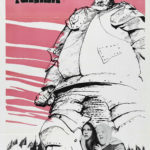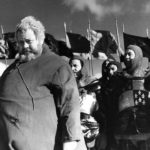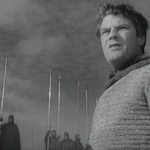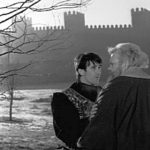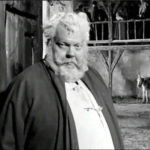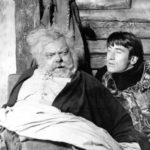You have to hand it to Orson Welles – he had the power to shock and surprise right to the end of his life. Granted he made some shocking movies along the way – even the mighty fail occasionally – but there are very few filmmakers credited with the greatest film of all time. After Citizen Kane, which itself attracted much controversy due to its satire on William Randolph Hearst, his career was marked by conflict with his financiers, including the permanent hacking by the studio of his masterpiece The Magnificent Ambersons.
True, he made some astonishing films along the way (I love A Touch Of Evil), but by 1965 almost everyone thought his movie career was washed up, and indeed this illustrious actor, director and producer went on to spend this twilight years making sherry commercials, which is how I remember him in the 70s. Certainly no studio was going to give him unlimited budget and unfettered artistic control ever again, despite his evident genius.
I’ve never seen Chimes at Midnight, a Spanish-Swiss coproduction in English since Hollywood would not touch Welles with a barge pole, before now. Perhaps I assumed it to be just another vehicle for Welles to earn a small living well within his capabilities by hacking Shakespeare, but it was Simon Callow who recently put me right during an excellent talk on Welles, about whom he has written three volumes of biography. Au contraire, it seems not only did Welles consider this film his masterpiece, but Callow himself found this an achingly moving film, sadly neglected and only recently restored to celebrate its 50th anniversary.
Certainly Welles attracted a fine international cast of classical actors, with John Gielgud as Henry IV, Ralph Richardson narrating, Margaret Rutherford as a sharp-tongued Mistress Quickly, Fernando Rey as Worcester (albeit dubbed), Jeanne Moreau as Doll Tearsheet, Andrew Faulds as Westmoreland, Keith Baxter as Prince Hal and Norman Rodway as Hotspur, to name but a few. He also scored a hit by bringing in French cinematographer Edmond Richard to film in monochrome with glorious contrast, which seems so right in many ways.
The essence of this movie is to fillet dialogue from the historical plays of our illustrious bard (Henry IV parts 1 and 2, Henry V, Merry Wives of Windsor, Richard II), chronologically rearranged and stitched together to tell the story of the tragicomic anti-hero Falstaff, a much loved character whose role and reputation have been re-evaluated on stage in recent years by a succession of very fine actors, and who also appears in at least three operas!
Apart from possessing something close to the figure for Falstaff, Welles demonstrates that his is a worthy addition to the names interpreting this inspired character. Falstaff is a rogue and a knight, more given to wenching, drinking sack and getting up to mischief. He is a coward, for whom fighting for his king is a duty but only to be served without endangering his own life.
However, Falstaff talks up his own bravado, none more so than when Hal, who thinks Falstaff is dead, kills the valiant Hotspur in battle, only for Fat Jack later to claim they fought on and that he struck the fatal blow. The knockabout comedy contrasts sharply with the sober realities of life in court, where Hal knows from his father only too well that he must give up associating with a fat rogue and assume the serious mantle of monarchy.
The film emphasises both the comedy and the pathos of Falstaff’s role, albeit in a more traditional setting than typically employed in stage productions. Most noticeable is how Welles plays up the farce of Falstaff’s band and followers (Pistol, Shallow, Bardolph), but underplays Falstaff in a way that demonstrates the underlying tragedy of the role. The effect is electric later in the film, notably the coronation scene where Falstaff seeks out the newly crowned Henry V, only to be told, “I know thee not, old man.” Falstaff looks back uncomprehendingly, but we can see this to be the end of Falstaff’s life in more ways than one.
The contrast between jovial scenes in the Boar’s Head Tavern and the more formal affairs of state is marked with the Battle of Shrewsbury. I quote from Wikipedia (more quotes at the bottom):
The film’s most famous sequence is the Battle of Shrewsbury; only about 180 extras were available and Welles used editing techniques to give the appearance of armies of thousands. Welles filmed all of the battle scenes in long takes, but cut the shots into fragments to create the effect that he wanted. It took ten days to shoot the scenes and six weeks to edit what became a six-minute sequence. In filming the sequence, Welles often used hand-held cameras, wide-angle lenses, slow motion and speed up shots, static shots, swish pans and constant rapid movement of the characters to create a kinetic and chaotic atmosphere. Anderegg has said that “in the end, both armies have become one huge, awkward, disintegrating war machine, a grotesque robot whose power source slowly begins to fail and finally comes to a frozen halt. Verbal rhetoric—language itself—seems, for the moment, both irrelevant and obscene.”
The Battle of Shrewsbury sequence has often been called an anti-war statement by film critics and likened to contemporary films like Dr. Strangelove and Culloden. Shakespearean scholar Daniel Seltzer said that “the social consciousness of the movie is as alert as Shakespeare’s, and thematically pertinent in Shakespearean terms too … the footage of the Battle of Shrewsbury itself must be some of the finest, truest, ugliest scenes of warfare ever shot and edited for a movie.” Welles scholar James Naremore said that “the underlying eroticism of the chivalric code … is exposed in all its cruel perversity.” Tony Howard wrote that Welles used Shakespeare’s historical plays “to denounce modern political hypocrisy and militarism.”
According to Callow, when the cameraman suffered a seizure, Welles picked up the camera himself and carried on filming with an intensity rarely mirrored in any movie. These scenes are truly startling and innovative, even now. It is frenzied, vicious, barbaric – remembering there was no CGI to depict the horrors of battle in the way that Game of Thrones has achieved, for example.
This is an astonishing achievement, one for which Welles was justly proud – but it is to the shame of the movie industry that he had to beg, borrow and steal what he could to finance this epic, as he did throughout his entire career. Who knows what Welles might have made, had he not earned a reputation as a dangerous maverick?
___
Welles considered Falstaff to be “Shakespeare’s greatest creation” and said that the role was “the most difficult part I’ve ever played.” Keith Baxter believed that making the film was Welles’s life’s ambition. Before the 1939 Boston premiere of Five Kings, Welles told journalists “I will play him as a tragic figure. I hope, of course, he will be funny to the audience, just as he was funny to those around him. But his humor and wit were aroused merely by the fact that he wanted to please the prince. Falstaff, however, had the potential of greatness in him.” Reviews for the 1939 play mention Welles’ choice to downplay the traditional comedic elements of Falstaff in his performance. This reverence for the character increased over the years and by the time Welles made Chimes at Midnight, his focus was entirely on the relationships between Falstaff, Hal and Henry IV. He believed that the core of the story was “the betrayal of friendship.” Welles called Hal’s rejection of Falstaff “one of the greatest scenes ever written, so the movie is really a preparation for it. Everything prepares for it.” Throughout the film, Hal constantly turns his back on Falstaff, foreshadowing the film’s ending.
Welles said, “the film was not intended as a lament for Falstaff, but for the death of Merrie England. Merrie England as a conception, a myth which has been very real to the English-speaking world, and is to some extent expressed in other countries of the Medieval epoch: the age of chivalry, of simplicity, of Maytime and all that. It is more than Falstaff who is dying. It’s the old England dying and betrayed.” Many film theorists and Welles biographers have written about the recurrent theme of the “Lost Eden” in Welles’s work and of characters who are nostalgic for an idealized past, which Welles called “the central theme in Western culture.” Welles told Peter Bogdanovich that “even if the good old days never existed, the fact that we can conceive of such a world is, in fact, an affirmation of the human spirit.” Film scholar Beverle Houston argued that this nostalgia made Welles’s depiction of Falstaff infantile and called his performance a “[p]ower baby … an eating, sucking, foetus-like creature.” Welles also called Falstaff “the greatest conception of a good man, the most completely good man, in all of drama”, and said that “the closer I thought I was getting to Falstaff the less funny he seemed to me. When I played him before in the theater, he seemed more witty than comical. And in bringing him to the screen, I found him only occasionally, and only deliberately, a clown.”
“[Falstaff]’s good in the sense that the hippies are good. The comedy is all about gross faults in the man, but those faults are so trivial: his famous cowardice is a joke— a joke Falstaff seems to be telling himself against himself…he asks for so little, and in the end gets nothing.” – Welles on Falstaff
Keith Baxter compared Welles to Falstaff, since they were both perpetually short of money, often lied and cheated people to get what they needed and were always merry and fun loving.[53] Film scholar Jack Jorgens also compared Welles to Falstaff, stating that “to a man who directed and starred in a masterpiece and has since staggered through three decades of underfinanced, hurried, flawed films, scores of bit parts, narrations, and interviews which debased his talent, dozens of projects which died for want of persistence and financing, the story of a fat, aging jester exiled from his audience and no longer able to triumph over impossible obstacles with wit and torrential imagination might well seem tragic.” When Joss Ackland played Falstaff on the stage in 1982, he said that he was more inspired by Welles than by Welles’s performance as Falstaff, stating that “like Falstaff, I believe he could have achieved so much, but it was frittered away.” Kenneth S. Rothwell has called Hal’s rejection of Falstaff allegorical to Hollywood’s rejection of Welles. Welles had become deeply depressed in the late 1950s after the disappointment of making Touch of Evil, his intended Hollywood comeback.
Welles’s biographer Simon Callow has compared Falstaff to Welles’s father Richard Head Welles, stating that like Falstaff, Welles’s father was “a drunkard, a trickster, a braggart, a womanizer, a gentleman and a charmer—and he is rejected by the person he loves the most.” Welles’s father was an alcoholic and womanizer who would often take a teenage Welles along with him when he was indulging in his vices. Welles observed his father much like Falstaff is observed by Hal and depends on his young protégé to bail him out of trouble. The love triangle between Prince Hal and his two father figures, Henry IV and Falstaff, is also similar to Welles’s relationships with his father and the two men who became surrogate fathers to him: family friend Dr. Maurice Bernstein and Todd School for Boys headmaster Roger Hill. Both of Welles’s surrogate fathers disapproved of Richard Welles’s lifestyle and negative influence on Welles. When he was fifteen Welles took the advice of Roger Hill and told his father that he would not see him again until he cleaned up his act and stopped drinking. Welles’s father died shortly afterwards, alone and lonely, and Welles always blamed himself for his father’s death, stating “I always thought I killed him.”
Welles’s alleged biological son Michael Lindsay-Hogg, who was born out of wedlock to Welles and actress Geraldine Fitzgerald, first met Welles when he was 15 and later worked on the 1960 stage play Chimes at Midnight. This was the only significant amount of time that the two spent together and afterwards Lindsay-Hogg only saw Welles sporadically. Like Welles, Lindsay-Hogg had two surrogate fathers in addition to his biological father. In the late 1950s when she was 16, Welles’s eldest daughter Christopher Welles Feder cut off all ties with Welles under pressure from her mother, who disapproved of Welles’s influence on her. Welles and Feder later reconnected but their relationship never fully recovered. Welles’s youngest daughter Beatrice, who resembles her father as a young boy, appears in the film version of Chimes at Midnight.


